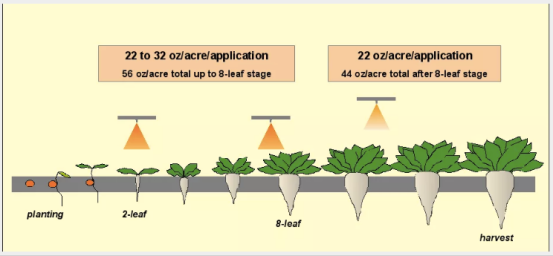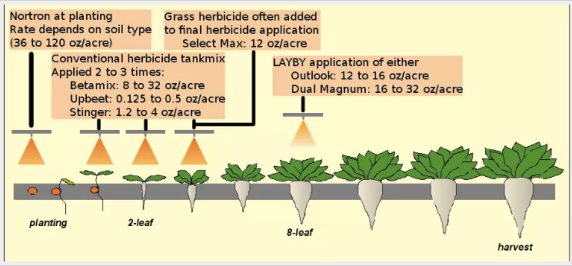In my series 17 Questions about Glyphosate, question 13. looks at glyphosate and its impacts on farming methods and the environment.
Even if glyphosate poses no risk for the consumers, perhaps its problems lie in the effects on the environment? Let’s look at some of the details.
13. Does glyphosate use enable bad farming practices?

Glyphosate helps preserve soils with no-till
Glyphosate is often used in combination with genetically engineered crops, particularly ones which are able to synthesise their aromatic amino-acids even in the presence of glyphosate. They are called RoundUp Ready (RR) crops, and are a big part of the existing Herbicide Tolerant Crops (HTCs). Many people believe this combination of RoundUp and GMO crops to be detrimental to the environment, but there tends to be little evidence to back up their assumption.
The USDA has actually documented the benefits to the environment from the combined use of herbicides and HTCs such as RR crops. The key benefit comes from how glyphosate enables farmers to omit the tilling step – move to no-till. Tilling leads to erosion and nutrient run-off, among other things, and avoiding it has many benefits. At USDA they write:
These trends suggest that HT crop adoption facilitates the use of conservation tillage practices. In addition, a review of several econometric studies points to a two-way causal relationship between the adoption of HT crops and conservation tillage. Thus, in addition to its direct effects on herbicide usage, adoption of herbicide-tolerant crops indirectly benefits the environment by encouraging the use of conservation tillage.
Should farmers be forced to stop using glyphosate, and revert to more tilling as their method of weed control, the prospects of increases in fuel use, reduced sequestration of soil organic matter, increased nutrient leeching, and increase in emissions would be significant.

Infographic from GMOs and the Environment
In other words, glyphosate use is part of the emission reductions attributable to biotechnology crops, which I have discussed earlier in my piece GMOs and the Environment.
This effect would be pronounced even in Europe, where the benefits of glyphosate use are not as large, as it is mostly not used in combination with biotech crops (which brings further benefits). To give an idea about that effect, I translated excerpts of a Finnish news piece on the topic below:
The [potential glyphosate] ban directly affects the cultivation technique. Instead of no-till the fields will have to be tilled. After that, the fields often need to be turned once more and stones must be collected,” the Copa-Cogeca Secretary-General Pekka Pesonen said.
“Without glyphosate, fuel consumption per-hectare will increase 20 to 30 liters. There will also be more work for the farmer, 15 to 18 hours more per hectare,” the German sugar beet farmer Bernhard Conzen said.
Tilling is one of the most detrimental methods for the environment. The less we rely on tilling, the better for the goal of sustainable farming practices. For more on that, you can read an excellent piece on what sustainable practices mean on Biofortified. The weed ecology professor Andrew Kniss has also written on the subject. In his excellent piece about trade-offs in agriculture, he writes:
If we truly want to encourage crop diversity, then glyphosate use can be a powerful tool in allowing those diverse crop rotations while still managing weeds.
And what about the environmental costs of reducing glyphosate use? One study estimates that using glyphosate herbicide in conjunction with glyphosate-resistant corn and soybean have prevented 41 billion lbs of CO2 from being released into the atmosphere between 1996 to 2013. Adoption of glyphosate-resistant soybean was recently estimated to have increased soil conservation tillage practices by 10, and notill adoption by 20%.These practices help reduce soil erosion, and the many environmental problems associated with soil erosion. Is a reduction in glyphosate worth an increase in erosion and worsening climate change? I acknowledge this trade-off is far too simplistic, as there are ways to mitigate these impacts. But those options have costs also.
It is not enough to pose the question: does glyphosate present a risk? We also have to take in consideration the question: what are the risks if we do not allow farmers to use glyphosate?
If you listen to the sugar beet farmers who are hurt by companies yielding before popular fears of glyphosate and biotechnology, the risks are great indeed. In the NPR piece As Big Candy Ditches GMOs, Sugar Beet Farmers Hit A Sour Patch:
Part of Grant’s intense interest in [GMO] beets definitely stemmed from his own farm’s experiences with the “traditional regimen” of herbicide products and application timing and methods. “It was a nightmare,” he recalls of those pre-Roundup days. “We had failures all the time — fields that would become unharvestable because of our failure to control weeds. We had an army of people applying herbicides around the clock or just at night. We did micro-rates, we did maxi-rates, you name it.”
“We had one sprayer for every 500 acres, so eight sprayers running around,” Grant relates. “They would work whenever they could. It might be all night long; it might be 24 hours straight because they had a window.
“It was a horrible life. Just last spring (of 2011), as the Roundup litigation was progressing through the courts and it was unclear whether we’d be able to plant Roundup Ready seed, my sugarbeet manager flat-out told me, ‘If we have to be conventional again, I’m quitting. I can’t do it.’

Glyphosate spraying scheme for RoundUp Ready sugar beets, from Plant Out of Place.
Andrew Kniss takes a detailed look at the fate of the sugar beet farmers in his piece As consumers shift to non-GMO sugar, farmers may be forced to abandon environmental and social gains, including these alternatives for pesticide application schemes.

What farmers used to spray before RoundUp Ready sugar beets, from WeedControlFreaks.
UPDATE: A recent a paper in Nature Communications by the weed ecologist Andrew Kniss analyses herbicide usage trends in the context of GMO crop adoption – in large part attributable to a shift to more glyphosate use in favour of other herbicides. His comments on the study, GMOs and Herbicides: it’s complicated:
In summary, this analysis suggests that GMOs have had a positive effect (or at the very least neutral or non-negative effect) with respect to herbicide use intensity and mammalian toxicity, and I’m sure that will disappoint many folks who don’t like GMOs.
He also summarizes his paper in a series of tweets, ending with the comment:
this bit is REALLY important, but also really difficult to quantify rigorously: Banning glyphosate would likely increase chronic toxicity hazard, since would likely be replaced with more toxic herbicides
To summarise: glyphosate is an important tool that helps make farming a more environmentally friendly practice with reduced carbon emissions.
But there’s more to the story. Next up: Glyphosate and Field Ecosystems, in which I look at the following questions:
- 14. What about resistance and superweeds?
- 15. Does glyphosate interfere with soil organisms or nutrient availability?
- 16. Does glyphosate harm Monarch butterflies or bees?

If you are interested in other environmental or health topics, you can find my other pieces on glyphosate over at 17 Questions about Glyphosate, and further resources under Farming and GMOs, The Environment, and Vaccines and Health. If you would like to have a discussion in the comments below, please take note of my Commenting policy. In a nutshell:
- Be respectful.
- Back up your claims with evidence.



Pingback: 13 of 17 – Glyphosate and The Environment – GMO Building Blocks
Pingback: The Interview: The Organic Crisis – Little Zurich Kitchen
Pingback: Do we fear the right things? | Thoughtscapism